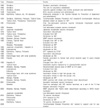Abstract
Figures and Tables
Fig. 2

Table 2

Abbreviations:Hep B, hepatitis B JE, Japanese encephalitis
*Data source:Korea Centers for Disease Control and Prevention: Monthly Newsletter for National Immunization Program, 5(7):26, 2007
†Private medical centers are assumed to report only 60% of actual immunization number based on previous research. So values from private medical centers were divided by 0.6 for correction
‡MMR coverage rate in this table is different from the result of the school-entry requirement for 2 doses of measles-containing vaccine (MCV2)
Table 3

Abbreviations:Hep B, hepatitis B; DTaP-O, DTaP with other vaccines; Var, varicella; JE, Japanese encephalitis JE-O, Japanese encephalitis vaccine with other vaccines HFRS, hemorrhagic fever with renal syndrome; Flu, influenza; Typ, typhoid fever
*Data source: Korea Centers for Disease Control and Prevention: Guideline for Management of Adverse Events Following Immunization, 2007
†Catch-up campaign with MR vaccine was performed as a part of '5-Year Measles Elimination Program' in 2001
‡Report of adverse events after BCG vaccination was managed dualistically before 2005 and integrated from 2005
Table 4

Abbreviations: IPV, inactivated polio vaccine; Hib, Haemophilus influenzaetype b, Hep A, hepatitis A Hep B, hepatitis B; JE, Japanese encephalitis; HPV, human papillomavirus; HFRS, hemorrhagic fever with renal syndrome
*Data source: Korea Centers for Disease Control and Prevention: Monthly Newsletter for National Immunization Program, 5(7):117-118, 2007




 PDF
PDF ePub
ePub Citation
Citation Print
Print





 XML Download
XML Download